BY MARINA RICHIE
Hidden in the Details: Protecting the Metalmark Butterfly
December 2, 2022
An effort to revive the rare northern metalmark butterfly will benefit a wide range of other native species along the A.T.
When news of the monarch’s globally endangered status fluttered across headlines in July 2022, another imperiled butterfly story unfurled on a patch of the Appalachian Trail corridor in western Connecticut. There, a multi-year effort to revive the northern metalmark butterfly reveals one potential flight path for recovery.
That path? The butterfly leads and biologists follow. The resulting habitat restoration is finely tuned over time. Appalachian Trail Conservancy (ATC) staff and partners have pulled invasive barberry and bittersweet, planted nectar wildflowers, and felled single trees to create sunny glades within the hardwood forest canopy. Each tweak to remove a threat or enhance metalmark habitat results from what the butterflies teach the scientists.
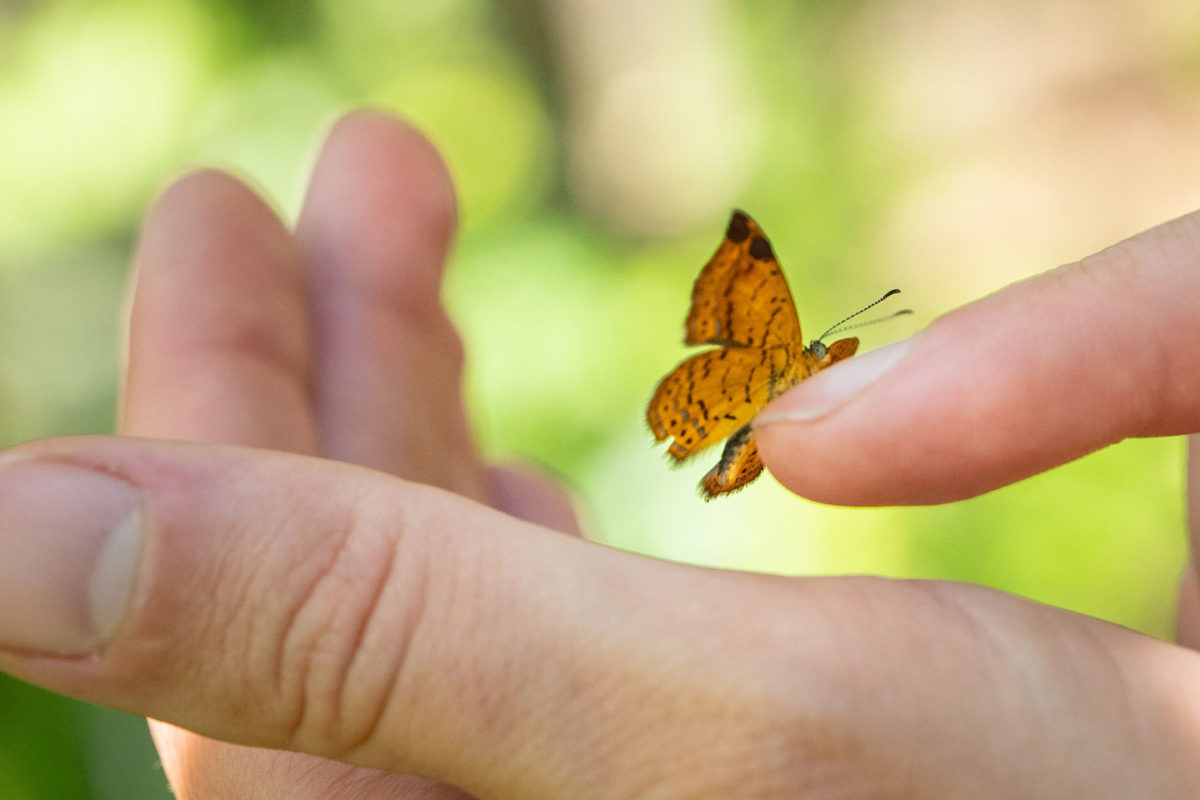
Help Us Protect the Trail’s Most Vulnerable Species
Your support is essential to our efforts to preserve the Appalachian Trail and all of the native species that call it home.
Photo: Chris Gallaway/Horizonline Pictures
At first glance, a northern metalmark appears the opposite of a monarch reigning over wildflowers in a royal cloak of orange wings etched in black. Where the monarch is a long-distance migratory champion, the demure metalmark is a stay-at-home specialist few people will ever see. Monarchs face dangers from Canada to Mexico; a whole colony of metalmarks can be eliminated in one fell blow (as happened in Connecticut at a rock quarry). However, the two butterflies share striking qualities as pollinators reliant on one kind of caterpillar host plant. For the monarch, it’s milkweed. For the northern metalmark, the host is roundleaf ragwort. Both butterflies are at high risk of vanishing forever unless people care enough to take meaningful actions based on science — not just once, but over the long run.
While the northern metalmark’s future is far from secure, ATC seasonal biologists Fern Crossway and Leo Wahl recorded an uptick in numbers in a population along the A.T. last summer. So elusive are the butterflies that the biologists equipped with elongated nets had to pay keen attention among forest glens and meadows. “It’s like finding a gemstone,” says Crossway. “They are hidden in tiny pockets.”

The metalmark’s undersides reveal bright tangerine hues. Photo by Chris Gallaway/Horizonline Pictures
Elemental Disguise
Resting on a wild raspberry bush with wings open in a moth-like pose, a metalmark might be mistaken for an inch-long brown leaf upon the greenery. On closer inspection, the colors are velvety cinnamon and nutmeg with a hint of blue, patterned in faint black scallops and inscribed with the namesake metallic filagree. The undersides reveal bright tangerine hues. “We’re often drawn to showy species, but if you take a little time to observe, you will likely find beauty hidden in the details,” says Marian Orlousky, the ATC’s director of science and stewardship. “They have these fine silvery marks that glimmer.”
After Orlousky rounded up partners and funding for a six-week-long monitoring season, Crossway and Wahl began tracking and gathering new information for the northernmost population found near the A.T. They recorded specific locations with GPS, determined two favorite wildflowers for nectar (black-eyed Susan and butterfly milkweed), and noted clustering behaviors within an area of ten square meters, the size of a typical bedroom. From mid-June to mid-July, they tracked and marked 155 adults — up from 117 in 2019 and 89 in 2018.
BUTTERFLIES ARE THE CHARISMATIC AMBASSADORS FOR THE MULTITUDES OF INSECTS THAT FAMED BIOLOGIST E.O. WILSON TERMED: “THE LITTLE THINGS THAT RUN THE WORLD.”
Central to the project is University of Connecticut’s Dr. David Wagner, professor of ecology and evolutionary biology and author of a 2021 report titled “Insect Decline in the Anthropocene: Death by a Thousand Cuts.” The report highlights the colliding forces causing the insect apocalypse, from global warming and related extreme weather to deforestation, industrial agriculture, insecticides, urbanization, and introduced species. Wagner initiated monitoring at this site in 2007. Crossway and Wahl conducted summer research under Wagner in 2022 and recently received their undergraduate degrees from the State University of New York College of Environmental Science and Forestry.

The art of gentle capture requires certain ways of swinging the translucent net while walking in one direction on a path to prevent scooping up a butterfly twice in a day. Wahl and Crossway alternated walking and pausing to scan for butterflies in the air. Photo by Chris Gallaway/Horizonline Pictures
Save Every Species
Why put such intensive labor into saving one isolated population of a rare butterfly within the A.T. corridor? I decided to ask Dr. Douglas Tallamy, the entomologist and biologist who is fostering the rewilding of yards and lawns with his advocacy and best-selling books Nature’s Best Hope and Bringing Nature Home. “Saving biodiversity is not optional,” Tallamy says. “We have to save it for our own good.”
Every species plays a critical role in the stability and productivity of our ecosystems that are essential for all life, Tallamy explained. Both endangered and common insects are showing alarming declines in populations. We must act swiftly. That sometimes means stepping in to help nature contend with our human-caused meddling, like introduced plants overwhelming and even eliminating the native wildflowers butterflies rely on. Tallamy calls the protected A.T. “a lifeline and connection to the natural world from Georgia to Maine.”
Within the 2,194-mile-long corridor, the ATC’s science and stewardship team is vigilant in identifying threats, monitoring declining species, and taking action to keep the “Wild East” corridor strong and functioning for all plants and animals, including more than 1,800 vulnerable species. The work done to protect the imperiled metalmark butterfly will further benefit a wide suite of other native species that rely on the same high-quality habitat.

Marking each butterfly is a delicate matter. While temporarily asleep, dots are applied to the underside of an individual’s wings, following a systematic numbering scheme. Then, the awakening metalmark is conveyed to a flower and watched over until fully awake. Photo by Chris Gallaway/Horizonline Pictures
“WE’RE OFTEN DRAWN TO SHOWY SPECIES, BUT IF YOU TAKE A LITTLE TIME TO OBSERVE, YOU WILL LIKELY FIND BEAUTY HIDDEN IN THE DETAILS. THEY HAVE THESE FINE SILVERY MARKS THAT GLIMMER.”
Finicky Flyers
While historically common, the northern metalmark butterfly is now critically imperiled and found in small, isolated pockets throughout its range, extending from western Connecticut south through west-central Pennsylvania, the central Appalachians, and the Ohio River Valley (with isolated pockets in southwest Missouri and eastern Oklahoma). Connecticut lists the species as officially endangered.
To be a northern metalmark is to live on the edge — literally. Where two habitats meet, they sip nectar from radiant flowers within sun-dappled glades on forest slopes, and only where red cedar grows in calcareous soils formed by limestone. These sunny openings are often no bigger than a double door and are typically near rivers with limestone outcroppings. Generations of northern metalmark must find all their habitat needs at every point in their life cycle within a small range often an acre or less in size.
After a flurry of aerial courtship and mating, a female chooses a host plant to her liking. Once satisfied, she lays a teensy turban-shaped egg on the underside of a low-growing new leaf of a roundleaf ragwort. The host plants form rosette mats of shiny emerald leaves so close to the ground that it’s impossible to avoid stepping on them if off the trail. They grow only on slippery, erodible slopes on the same calcareous soils and often in shade. Their yellow aster-like flowers bloom before metalmark adults take flight. The butterfly life is brief, lasting for two weeks from the end of June to mid-July.
In August, the hairy little caterpillars hatch to feed on ragwort leaves. Their meals are so tiny it’s difficult to notice the munching. By fall, they burrow into the soil and sleep until spring. Then, the half-grown caterpillars eat and grow until mid-June, when they form their chrysalises on the soil around ragworts. By month’s end, the crowning moment of metamorphosis arrives — voila! The winged adults emerge to fly and find their special nectar plants. Assuring the right wildflowers are blooming at the right time in the right places is one of the restoration challenges. While it’s tempting to call northern metalmarks finicky, their behaviors reflect an exquisite evolution. Consider this: The oldest butterfly fossils date to 200 million years ago and over time diversified into the kaleidoscopic array of some 17,500 species in the world with 750 in the U.S. — each with a remarkable life history.
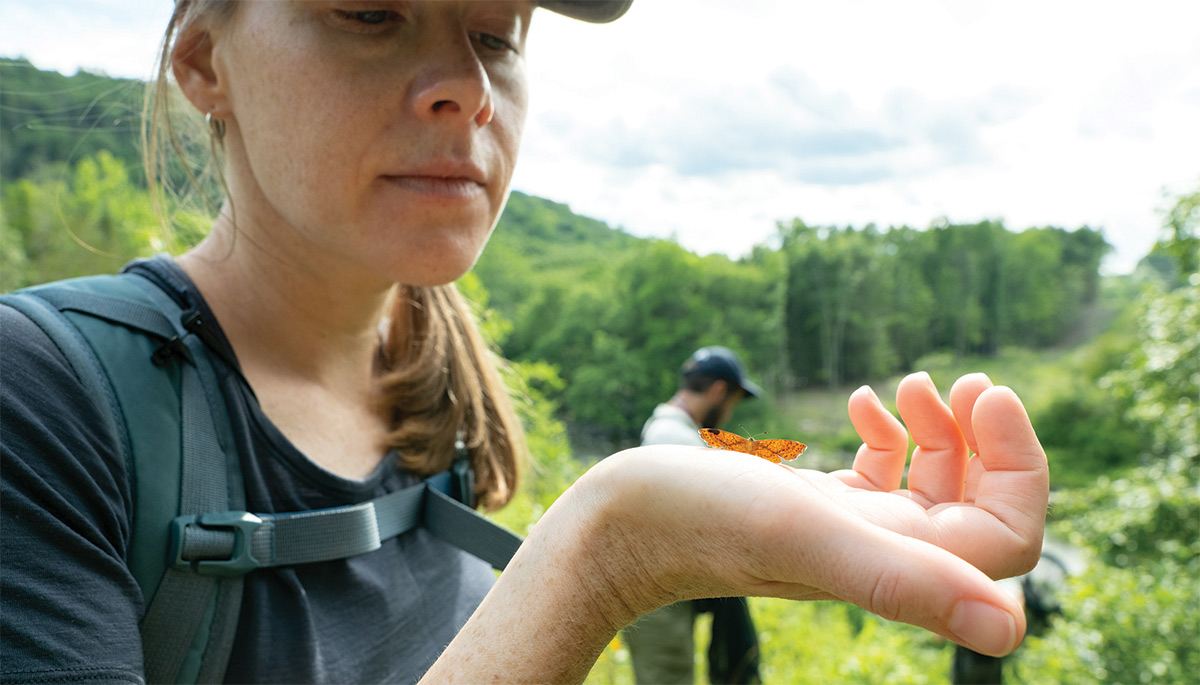
Marian Orlousky, the ATC’s director of science and stewardship, studies a freshly marked butterfly as it awakens. Photo by Chris Gallaway/Horizonline Pictures
ASSURING THE RIGHT WILDFLOWERS ARE BLOOMING AT THE RIGHT TIME IN THE RIGHT PLACES IS ONE OF THE RESTORATION CHALLENGES. WHILE IT’S TEMPTING TO CALL NORTHERN METALMARKS FINICKY, THEIR BEHAVIORS REFLECT AN EXQUISITE EVOLUTION.
Catch and Release
Fresh from a spring project tracking a butterfly called a frosted elfin, Crossway and Wahl soon found they’d met their match. “These butterflies are small, quick, and good at getting out of the net,” says Wahl. The art of gentle capture requires certain ways of swinging the translucent net while walking in one direction on a path to prevent scooping up a butterfly twice in a day. One technique is to drop the net on top of a flower or bush as a butterfly rises to escape. But the metalmark flies down and disappears. So, Wahl and Crossway alternated walking and pausing to scan for butterflies in the air. If not seeing one, they would swish their nets over the flowers to entice them into flight, and then would come the practiced swoop. Caught!
Next came the act of coaxing a butterfly into a jar to be put into a brief sleep for recording details, including noting the sex. A female differs from a male with a slight curvature of her wing and a larger abdomen. To mark an individual took applying dots in a recognizable pattern on wing undersides. Then, the awakening metalmark would grasp Crossway or Wahl’s fingertip to be conveyed to a leaf and watched over until fully recovered. Often they’d recatch butterflies the following day, and over the season marked an estimated eighty percent of the population.
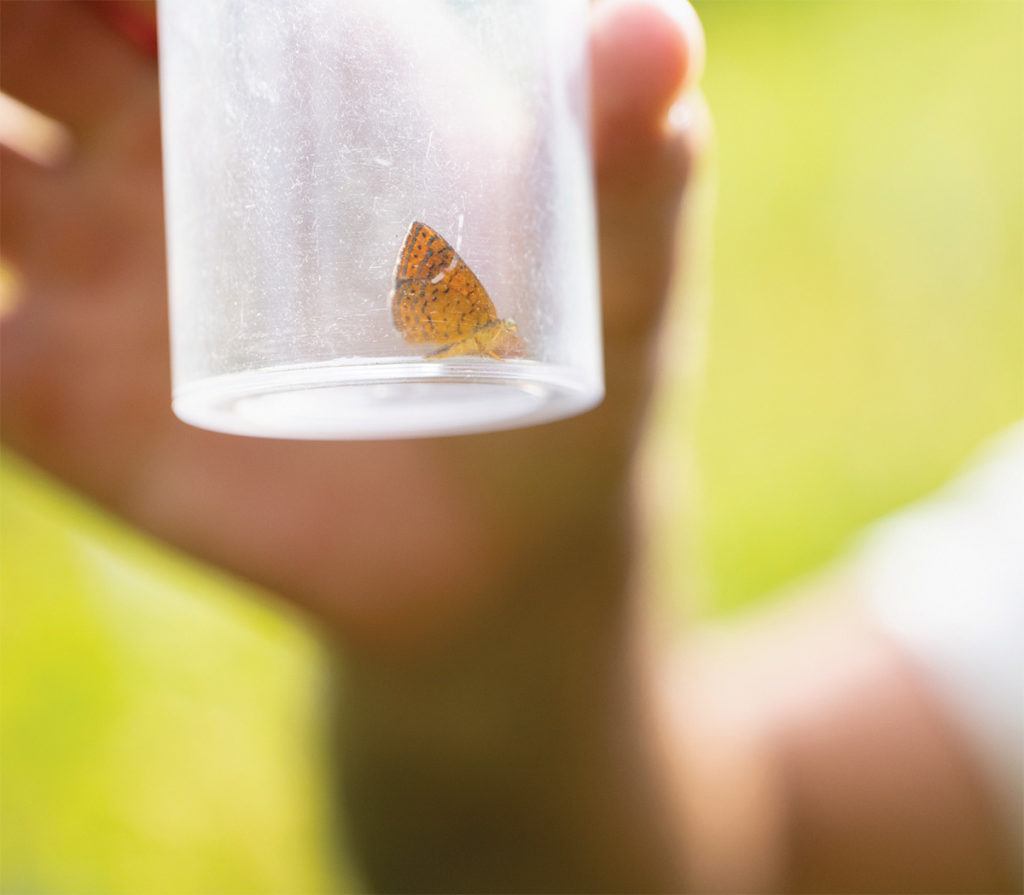
A newly caught butterfly is transferred from net to jar so it can be assigned and marked with a unique identification number. Photo by Chris Gallaway/Horizonline Pictures
In addition to their quarry, the biologists recorded all butterflies and moths observed or netted, including Delaware skippers, great spangled fritillaries, satyrs, wood nymphs, and once a state-listed rarity called a juniper hairstreak. While monarchs were not on their list, they believe the site could attract them by planting more milkweed species. Crossway also photographed a sampling of stunning insect diversity integral to the metalmark’s world. Each species plays a pivotal part in the ecosystem, from American carrion beetles feeding on decaying plants and recycling nutrients to wide-footed treehoppers. Blending in like thorns, the treehoppers extract sap from goldenrod and aster without harm to the pollinator plant. Ants milk them for their honeydew and guard them from predators, although many treehoppers become tasty meals for songbirds.

Crossway and Wahl patiently wait as a butterfly falls asleep before they can study and mark it. Photo by Chris Gallaway/Horizonline Pictures
FOR ALL WHO HIKE AND PROTECT THE APPALACHIAN TRAIL, THE REWARDS OF ENDURANCE, RETURNING, AND GIVING BACK COME IN MANY FORMS, INCLUDING A DEEPENING RELATIONSHIP WITH WILDLANDS AND WILDLIFE.
Pollinators and Powerlines
Biodiversity matters, and sometimes species-rich habitats come in surprising forms. Not all lands are pristine and, when damaged, the challenge is to make the best use of them for conservation. For powerlines, that translates to restoring native wildflowers and shrubs and not spraying herbicides or ripping out vegetation to be replaced with rocks. As awareness grows of the importance of powerline cuts for the future of pollinators, more utility companies are changing their practices and joining partnerships like saving the vulnerable metalmark butterflies in Connecticut.
A powerline cut composes one of the habitats for a certain flock (called a flutter) of the metalmarks Crossway and Wahl followed. However, the butterflies led them to only one edge near the river as a favored locale for preferred wildflowers, shrubs, and nearby host plants. Regular communication with the utility company is critical to avoid inadvertent damage from clearing trees and brush to keep the strip open below the electrical lines. “Minor shifts in policies can make a big difference,” the ATC’s Orlousky says. “When you commit to the long vision, there can be positive change.”

The dark green leaves of the roundleaf ragwort (packera obovata) serve as the sole food source for young metalmark caterpillars; inset: tiny, turban-shaped eggs are laid on the underside of a roundleaf ragwort. Photo by Fern Crossway
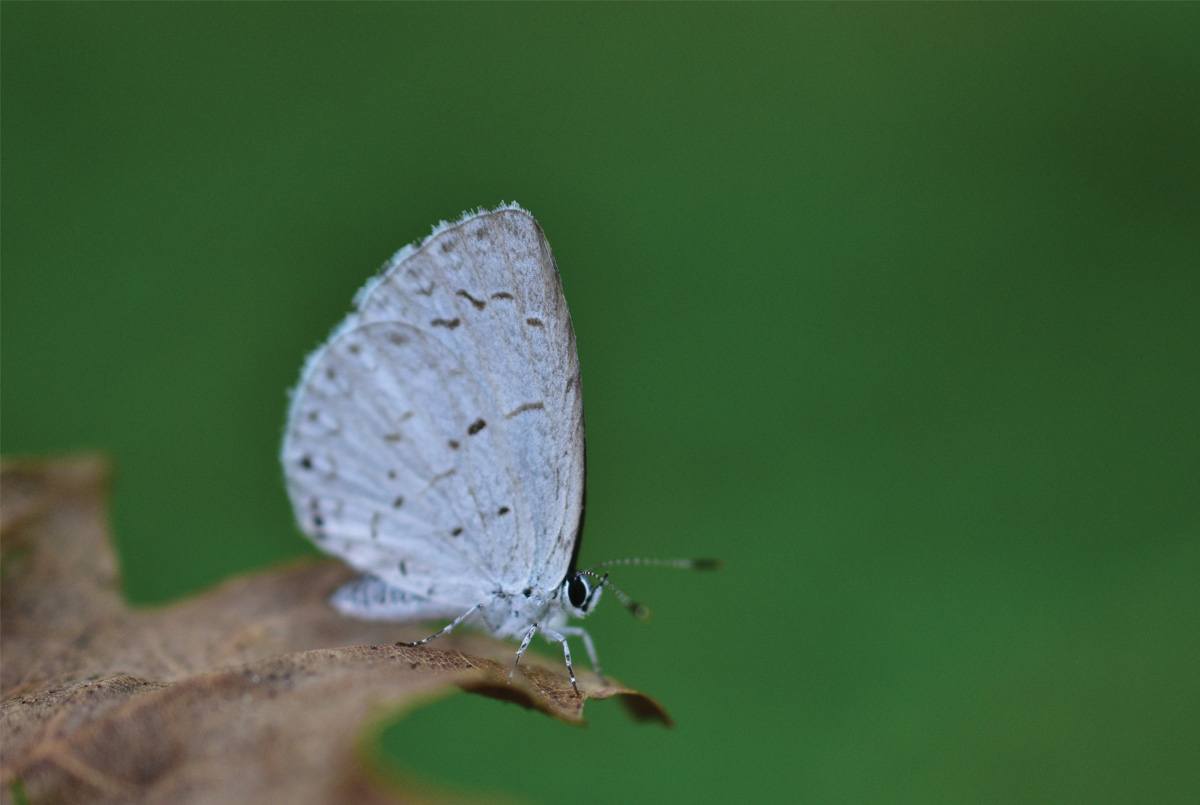
A summer azure (celastrina neglecta) rests on an oak leaf in metalmark habitat. The two species depend on many of the same native flowers for their survival. Photo by Fern Crossway

Protected waterways and native flora are a vital part of a healthy ecosystem that spans the A.T. Corridor. Photo by Fern Crossway
Rewards of Reciprocity
For all who hike and protect the Appalachian Trail, the rewards of endurance, returning, and giving back come in many forms, including a deepening relationship with wildlands and wildlife. Add in the story of this quest to save the northern metalmark butterfly, and I’m hoping more than a few hearts are fluttering with pride to be part of the A.T. legacy. Tallamy has a message for A.T. hikers as well. Take the love for the Trail back home and add your voice to all who are calling for saving biodiversity. Take personal actions wherever possible, like gardening for wildlife with native plants. “Even if you live in an apartment in a city or don’t own any property, you can help the A.T.,” he says. “The only way we are going to make conservation a grassroots effort is to convince everybody.”
About the Author
Marina Richie is the author of Halcyon Journey: In Search of the Belted Kingfisher (Oregon State University Press, 2022), the first book to feature a beloved bird of North America’s waterways, including streams, rivers, ponds, and lakes along the Appalachian Trail. Learn more at marinarichie.com. This article originally appeared in the Spring/Summer 2022 issue of A.T. Journeys, the membership magazine of the Appalachian Trail Conservancy. Subscribe today by becoming an ATC member.
Discover More
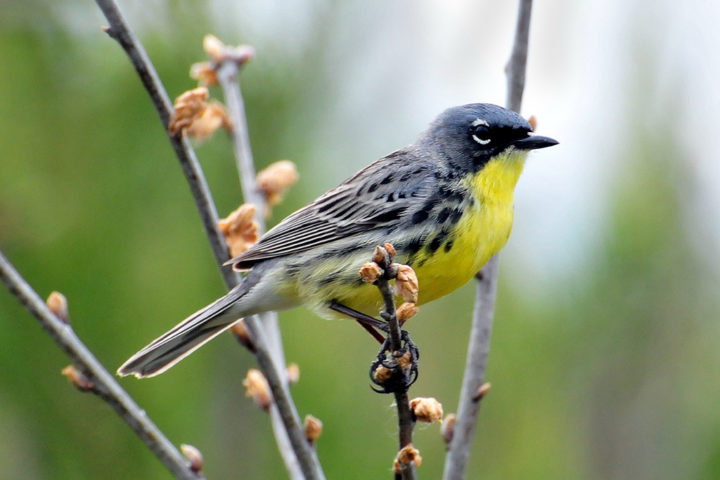
By Marina Ritchie
Wild Skyway
Wherever you are on the Appalachian Trail, birds offer sweet companionship. Yet, as hiker numbers soar, bird populations tumble.

Official Blog
A Deeper Connection
Embracing and encouraging a sense of belonging about the A.T., and turning that feeling into action, is the work of the A.T. Landscape Partnership.

A Strong Future
Conservation
As stewards of the Appalachian Trail, our goal is to ensure it will be enjoyed for centuries to come.
